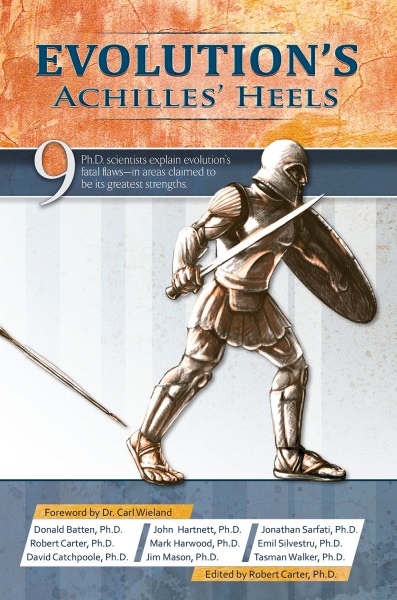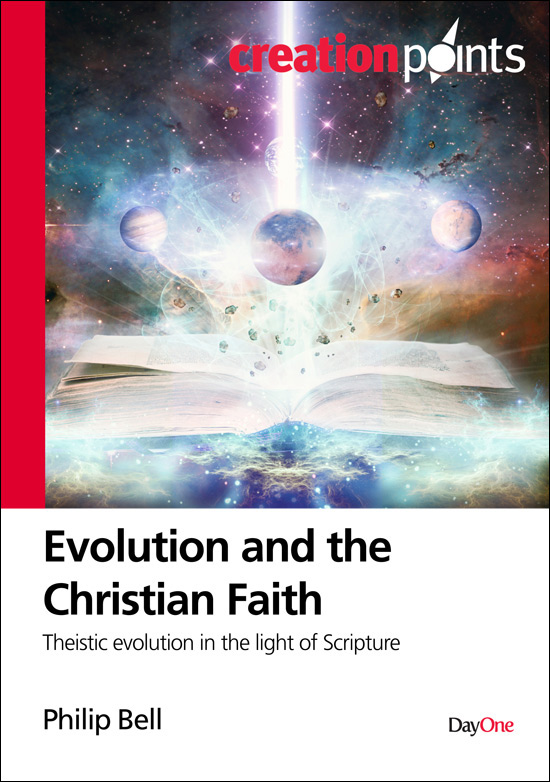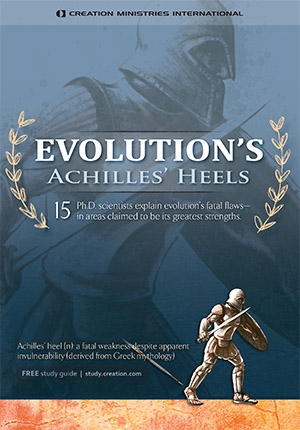Journal of Creation 38(1):110–117, April 2024
Browse our latest digital issue Subscribe
What’s wrong with being wrong: part 6—a more than cursory look into evolutionary ethics
In previous parts I addressed the chief evolutionary explanations for morality’s and altruism’s appearance and spread. Although group selection, kin selection and reciprocal altruism are by far the most popular accounts, there are other options evolutionists have offered as support for an evolutionary understanding of morality. Three are examined here, a further four in the subsequent part.
Evolutionary explanations are fluid, sufficiently flexible to accommodate inconvenient data.1 In this sixth paper, and the sequel, the seventh, several additional evolutionary accounts for morality’s and altruism’s appearance are examined. Few are necessarily to the exclusion of any other, with evolutionists hedging bets and combining the explanatory worth of several accounts. Empirical validation is commonly thin and the combinatory thread of just-so stories and conjectured genetic mechanisms is advanced to shore up scientific respectability.
Goodness2
Though an exhaustive review of evolutionists’ explanations of humans’ inherent goodness is beyond this paper, they all follow naturalistic3 paths and arrive at a shared destination. At their core is agreement that ‘machinery’ exists which allows the ‘good’ to materialize. What form this ‘machinery’ takes is moot; central is the belief that humans possess an innate, evolutionary drive to seek this ‘good’, the inconvenient psychopath notwithstanding.4
Primatologist and ethologist Frans De Waal (figure 1) proposes that humans have inherited a good nature from our non-human ancestors.5 Our sense of right and wrong arose as an extension of social instincts of our primate relatives. More specifically, our ability to discern between good and evil is sourced from higher primates’ putative ability to express emotions, detect them in others and respond empathetically, punishing transgressors.
To shrink the discontinuity between human and nonhuman requires some verbal ‘fudging’, as philosopher Richard Joyce (figure 2) labels de Waal’s approach:6
“In discussing what constitutes morality, the actual behavior is less important than the underlying capacities. For example, instead of arguing that food-sharing is a building block of morality, it is rather the capacities thought to underlie food-sharing (e.g., high levels of tolerance, sensitivity to others’ needs, reciprocal exchange) that seem relevant. … whether animals are nice to each other is not the issue, nor does it matter much whether their behavior fits our moral preferences or not. The relevant question rather is whether they possess capacities for reciprocity and revenge, for the enforcement of social rules, for the settlement of disputes, and for sympathy and empathy.”7
Not to put too fine a point on it, de Waal cheats. His studies assume chimps, his primary animal subject, are a rudimentary source of human morality in hominid evolution. While not denying the evolutionary relationship, Joyce nevertheless accuses him of blurring the evaluative distinction between the predictive and/or instrumental, and truly moral. Predictive ‘oughts/shoulds’ “suggest the likelihood of something occurring” (e.g., given today’s hot weather, it should rain this evening), while instrumentals entertain a hypothetical end (e.g., ‘If I want to pass my exam, I should study’). Joyce then undermines de Waal’s entire project with a single remark:
“… though it may be permissible to ascribe animals certain mental states whose contents involve the word ‘ought’ or ‘should’ [in the predictive and instrumental connotation], this may do nothing to establish the legitimacy of ascribing to them moral judgments [emphasis in original].”8
Joyce’s criticism draws our attention to fundamental epistemic difficulties of assigning moral appraisal to behaviour, particularly whether the normative can be in virtue of, or grounded by, non-moral or natural properties.9 De Waal fails to observe the metaphysical boundary separating these two worlds, which facilitates his Trojan Horse descriptive smuggling the normative inside its belly. By conveniently underplaying the moral quiddity imbedded in human “reciprocity and revenge, for the enforcement of social rules, for the settlement of disputes, and for sympathy and empathy”, he can present them as morally neutral in chimps, by labelling them ‘capacities’, which ultimately carry into the human line.
Discharging one’s burden of proof for any claim, especially extraordinary ones, is a well understood principle. It is an uncontroversial epistemic duty, if not a moral one.10 De Waal loses sight of his obligation to explain why reciprocity, tolerance, punishment, and the like, involve a capacity for moral deliberation. De Waal does not provide a single justification for this overextended assertion. To imply that apparent analogous behaviours in humans and chimps are for the same ends, without considering they may be better explained by dissimilar causes and goals, begs the question by assuming that these chimp behaviours possess a latent moral quality (or in his words, “a building block of morality”) which was the evolutionary antecedent for human morality.
Joyce reproaches de Waal for categorizing chimp behaviour as ‘accepted’ and ‘unaccepted’. These descriptors fail to come to terms with the truly moral. As Joyce points out:
“Th[ese are] very different from an awareness of acceptable and unacceptable behaviors—the difference being that the former implies only knowledge that certain behaviors will provoke hostility, whereas the latter implies a judgment that these behaviors merit hostility … the notions of merit and desert lie close to the heart of the moral judgment. Without them there can be no sense of justice, no guilt, and no moral conscience [emphases in original].”11
Central to his explanation is the hegemonic position emotions play in underpinning morality, what Kitcher calls an ‘alliance between Darwin and Hume’.12 Normally seen as the counterpoint to rationality, de Waal argues that emotions dominate and shoulder rational decision-making:
“People can reason and deliberate as much as they want, but … if there are no emotions attached to the various oppositions in front of them, they will never reach a decision or conviction. This is critical for moral choice, because if anything morality involves strong convictions. These convictions don’t—or rather can’t—come about through a cool rationality: they require caring about others and powerful ‘gut feelings’ about right and wrong.”13
Neuroscientist Antonio Damasio (figure 3) is likewise optimistic about man’s innate goodness. That man acquired this positive, life-affirming quality through an evolutionary struggle which eliminated the genetically inferior is beside the point. His metaethic of emotivism14 consigns ‘self’ to an evolutionary neuronal scaffolding process which has built the complexity of consciousness (not ‘mind’—he is, after all, a materialist!) from smaller parts, establishing a beachhead of ‘goodness’ while surrounded by a ‘nature, red in tooth and claw’.
Despite his sanguine expectation, Damasio is not blind to the abject mire in which humans are engulfed. While accepting the ubiquity of death, he longs for that salvatory truth, love. However, rather than discovering the good in the transcendent, he installs it in the biological, an inevitable outcome of his materialism and the evolutionary process:
“Does this mean that love, generosity, kindness, compassion, honesty, and other commendable human characteristics, are nothing but the result of conscious but selfish, survival-orientated neurobiological regulation? … . That is definitely not the case. Love is true, friendship sincere, and compassion genuine, if I do not lie about how I feel, if I really feel loving, friendly, and compassionate … . Realizing that there are biological mechanisms behind the most sublime human behavior does not imply a simplistic reduction to the nuts and bolts of neurobiology … . The picture I am drawing for humans is that of an organism that comes to life designed [sic] with automatic survival mechanisms and to which education and acculturation add a set of socially permissible and desirable decision-making strategies that, in turn, enhance survival, remarkably improve the quality of that survival, and serve as the basis for constructing a person [last emphasis added].”15
His argument is best understood as an attempt to bridge the gap between the body and metaphysics of ethical inquiry by relocating (Kant’s) noumenal to the phenomenal: “For most ethical rules and social conventions, regardless of how elevated their goal, I believe one can envision a meaningful link to simpler goals and to drives and instincts [emphasis in original].”16
His isn’t a novel idea: Complex neural networks, fashioned over millions of years produce and link the social rules and conventions. No need to connect the dots, and the entire process, its cumulative history, can be skipped.
These criticisms notwithstanding, his whole project grounds itself on an epistemic rock: it coheres only on the basis that ethical rules and socially permissible strategies are themselves ethical. This not only question-begs their ethical value, but also misses the burden of how their ‘moral point of view’, to use his wording, came into existence.
Dennett complained that creationists routinely invoked a supernatural skyhook to explain apparent design. Mutatis mutandis, I fail to see how Damasio has escaped Dennett’s criticism. Creationists’ ‘skyhook’ is recognition that creation is miraculous, the existence of which requires a creator. Damasio’s account, however, demands an infinity of natural-law-violating events elevated by a myriad of chimeric cranes.17,18
Ridley also explains human ‘goodness’ as an inevitable product of a lengthy evolutionary journey: “it would be simply inconceivable”, he muses, “to imagine … a world without obligations to reciprocate, deal fairly, and trust other people.”19 While acknowledging individuals and whole societies20 are capable of heinous crimes and selfishness (he lists many), Ridley, fuelled by an unwarranted optimism, opines that
“The roots of social order are in our heads, where we possess the instinctive capacities for creating not a perfectly harmonious and virtuous society, but a better one than we have at present. We must build our institutions in such a way that they draw out those instincts.”21
Pirating the language of revelation, Hauser champions the idea that humans are “handed down from on high” a culturally universal Golden Rule. This, he argues, is something which “emerges as an obligatory outcome” whenever “humans live in social groups”.22 Borrowing from Chomsky’s language acquisition thesis, and quasi-teleological in its confabulatory just-so account, Hauser sets out a case for millions of years of natural selection imbedding a cerebral universal moral grammar. This allows us to reconcile ethical dilemmas through relying on the ‘good’ part of ourselves: “Humans appear to be uniquely endowed with a capacity that enables large-scale cooperation among unrelated individuals, and to support stable relationships that rely on reciprocity.”23 Darwin, he said, “was correct in thinking that along the evolutionary path to our moral sense, nature must have added some extra accessories to the core, allowing individuals not only to care for others but to know why caring is the right thing to do, while harming is often the wrong thing to do.”24
Baron-Cohen, hardly alone in his belief, holds that inner goodness has a material location: “there are genes for empathy”. This bedrock of evolutionary thought is the materialists’ cash-cow meme. The proof?
“… scientists are starting to discover particular genes that in far-reaching ways influence our empathy. I restate that these are not genes for empathy per se but are genes for proteins expressed in the brain that—through many small steps—are linked to empathy. These steps are still to be clarified, but we can already see from statistical analyses that genes exist that are associated with empathy [a] discovery [which] will upset those who want to believe empathy is wholly environmental [emphases in original].”25
Emotions and feelings26,27
Primate behaviouralists argue that non-human primates do not always act from purely selfish motives but can recognize others’ needs and adjust their desires and emotions to match their conspecifics. Empirical data drawn from primate interaction (figure 4) indicate an animal will assist another experiencing distress. The anxious animal communicates its unease through noise or facial expression, which induces a similar emotion in a conspecific, leading the latter to aid the former. This mirroring effect is labelled ‘emotional contagion’.28 Some believe this ability laid the foundation for a complete moral faculty to evolve in humans:
“With increasing differentiation between self and other, and an increasing appreciation of the precise circumstances underlying the emotional states of others, emotional contagion develops into empathy. Empathy encompasses—and could not possibly have arisen without—emotional contagion, but it goes beyond it in that it places filters between the other’s and one’s own state … . Selection must have favoured mechanisms to evaluate the emotional states of others and quickly respond to them. Empathy is precisely such a mechanism. In human behaviour, there exists a tight relation between empathy and sympathy, and their expression in psychological altruism. It is reasonable to assume that the altruistic and caring responses of other animals, especially mammals, rest on similar mechanisms.”29
Early experiments involving rhesus monkeys30 discovered that individuals would starve themselves after pulling a chain which delivered food to them but simultaneously electrocuted a conspecific. This appeared to demonstrate primate empathy, an embryonic altruism. On such experiments the assumed evolutionary nexus between higher order primates and humans for the rise of morality was hoisted. This conclusion is not unequivocal. It is possible the monkeys were perfunctorily reacting to the distress, not consciously effecting solidarity with the sufferer.
To further support his thesis De Waal appealed to experiments carried out by Premack and Woodruff in which apes appear to altruistically help conspecifics. He cited the case of an older female in a zoo enclosure having a problem removing a tyre at the bottom of a six-tyre-deep pile. Eventually it gave up, and a juvenile, previously under its care, removed the tyres on top until it could free the one the female wanted and gave it to her.31 Kitcher, while conceding that the youngster was capable of a moderately intense psychological altruistic response, however argued that “there was little cost in interrupting his activities to help with the tires … in a context where not much else was going on.”32
It is interesting that one key reason de Waal rejects the Veneer Theory, which posits people as basically selfish and morality masks this fact, is that morality would be “reduced to calculations and reasoning, [and] we would come close to being psychopaths, who indeed do not mean to be kind when they act kindly.”33 Yet, his explanation seems incapable of escaping that which he finds so abhorrent:
“It should further be noted that the evolutionary pressures responsible for our moral tendencies may not all have been nice and positive … . In our own species, nothing is more obvious than that we band together against adversaries. In the course of human evolution, out-group hostility enhanced in-group solidarity to the point that morality emerged … . And so, the profound irony is that our noblest achievement—morality—has evolutionary ties to our basest behavior—warfare.”34
Any explanation must avoid circular reasoning. Placing emotion at the centre of morality fails this criterion: evolution occurred, so empathy must have arisen from more primitive emotions, and, since evolution has given humans morality, our empathic faculties arose from more primitive emotions.
Others are more candid concerning the link between evolution and how our emotions arose. Wright bluntly states:
“According to evolutionary psychology, human emotions were ‘designed’ by natural selection to serve the strategic interests of individual human beings … . In the case of friendly feelings, we are ‘designed’ to warm up to people who share our opinions on contentious issues because, during evolution, these are people it would have been advantageous to form alliances with. This is the generic reason that it is often hard for an outside observer to say whether a given human behaviour was driven more by strategic calculation or by emotions: because many emotions are proxies for strategic calculations. (As for why natural selection created these proxies for strategic calculation: these emotions evolved, presumably, either before our ancestors were very good at conscious strategic calculations or in cases where conscious awareness of the strategy being pursued was disadvantageous) [emphasis in original].”35
Creationists should not have a problem with emotions playing an important aiding role in moral decisions. Anger at an immoral act, which then spurs us into action, is appropriate. However, we should object to nonhuman emotion as an explanation for human morality. Being aggrieved about something, without rationality’s input as to why that something is morally wrong, is inadequate justification for moral disapprobation. ‘Aggrieved’, when applied to an animal’s response to its witnessing suffering in a conspecific, appears anthropomorphic and empirically unfalsifiable. It also begs the question of a pre-existing moral standard causing the emotion.
Selfishness
What seems in odd opposition to what goodness intrinsically is, one school of thought proposes morality appeared because of a lengthy history of selfish behaviour. This idea is that human ‘goodness’ is merely a biologically induced means to less selfless ends. Human ‘goodness’ is a veneer masking a Hobbesian brute.36 Man’s true nature is summed up in the cynicism of Ghiselin: “Scratch an ‘altruist’, and watch a ‘hypocrite’ bleed.”37
Wright echoes Ghiselin, believing that a hypocritical veneer38 of respectability conceals an underbelly of immorality and egoistic intentions:
“The pretense of selflessness is about as much part of human nature as its frequent absence. We dress ourselves up in tony moral language, denying base motives and stressing our at least minimal consideration for the greater good; and we fiercely and self-righteously decry selfishness in others.”39
Wright’s dystopian view is a bitter pill. All our lives, all our life, are as much mirage as they are true. Nothing is as it appears, and first impressions are, in all likelihood, lies and deception.
To balance this crushing pessimism, Wright frequently invokes an objectivist moral benchmark, without ever saying where this standard is located. Using expressions such as ‘truly moral’, he thinks that our moral ‘infrastructure’ is subjected to systematic ‘corruption’ causing humans to stray from ‘true morality’, and that this ‘corruption’ is “rooted in the genes (and is so rooted because it served the Darwinian interests of our ancestors during evolution).”40 And again:
“I do believe that some of our genetically based moral intuitions are (sometimes) subject to subtle biases that steer them away from the truly moral [and] I believe these biases to be themselves grounded in the genes, not mere ‘cultural overlay’ [emphasis in original].”41
Wright’s ultimate reliance on the gene and selfishness giving rise to a facade of selflessness is echoed by the philosopher Michael Ruse. He writes that morality is not objective according to any realist metaethic but is “a collective illusion foisted upon us by our genes”.42 Ruse, an atheist, understands well that eliminating God undermines any epistemic foundation to ethical objectivity. He ‘knows’ that rape and paedophilia are morally wrong, yet understands that one requires more than an appeal to emotions to condemn these heinous acts. What’s left is an illusion of objectivity masking morality’s actual state of subjectivity: “not only is Darwinian ethics a subjectivist ethics, it is one which positively excludes the objectivist approach … there are no objective ethics.”43
Richard Alexander, despite his focus on the group as the principal level for selection, in contrast to Dawkins’ emphasis on the gene, shares common ground with Ruse concerning human ‘disingenuousness’. In the penultimate paragraph of his seminal paper, Alexander writes:
“In human societies there is the additional problem of what motivations one communicates to his fellows, who should view with favor any evidently altruistic actions, including group-sustaining behavior, even if such actions are in reality ultimately selfish to the actor because of their group-maintaining aspects. It is not necessary that an appropriately selfish (i.e., maximally reproductive) individual be aware either of his motivations or of all of the consequences of his actions. Indeed, we frequently exhort our children to be (consciously) unselfish altruists, even though such tendencies would consistently be selected out of human populations, except for one paradoxical and crucial fact—that actions which would otherwise be truly altruistic may increase the reproduction of their bearer if they are viewed as true altruism by his fellows. If it is reasoned that parental exhortations to unselfish altruism have during human history led human progeny to reproductive success, then it might be argued that sincerity represents a valuable social asset even when it derives from a real failure to recognize the reproductively selfish background and effects of one’s own behavior.”44
Conclusion
I have examined three additional accounts for the rise of morality and altruism. There is a common misunderstanding to all three. Grounded meaning is replaced with question-begging descriptions of (presumed) good qualities: generosity, altruism, honesty, trust, and so forth. Giving examples of ‘goodness’ assumes a prior definition of ‘goodness’. What is missing is an answer to the question: what is goodness qua the good? This oversight is lost in the forest of just-so stories entertaining us about how it appeared in humans.
As with the three major explanations of group selection, reciprocal altruism and kin selection, these supplementary explanations suffer from another deficiency. There is a fundamental reliance on a genetic source for the ‘good’. This is yet another ‘missing link’ in the evolutionary tale. A related problem is their dependence on anthropomorphic descriptions of animal behaviour. Human emotions are read back into animals to unite the two genetic histories.
Finally, there is an epistemic oversight. There is a vast divide separating the ethical from the non-ethical. Assuming, rather than demonstrating, that the ethical can be grounded by matter not only fails to explain its origin, but, more importantly, is not a reason that we should believe it.
Creationists are encouraged to use this dearth of explanation as an apologetic against the evolutionary worldview.
In the next paper, I will review another set of evolutionary arguments advanced to explain morality’s and altruism’s origin.
Acknowledgments
I would like to thank two anonymous reviewers for their suggestions. I also wish to thank David Green for his input.
References and notes
- For example, to excuse its invisibility, some argue that “The types of genetic mutations that eventually lead to macroevolutionary changes are rare, and this accounts for the slow pace of evolutionary development” (Can evolution be observed, creation.com, accessed 10 Nov 2022, which cites biologos.org/ questions/what-is-evolution. However, BioLogos has since removed this entry). Others have described it as so ubiquitous that it is impossible to go unnoticed, yet, if not observed, it must have happened too quickly to be seen: “Evolutionary change is so nearly the universal rule that a state of motion is, figuratively, normal in evolving populations … . The most slowly evolving groups do all seem to be very highly and specifically adapted to a particular zone. Their typical history is one of rather rapid shift into a new, stable and persistent zone” (Simpson, G.G., Horotely, Bradytely, and Tachytely; in: Major Features of Evolution, Columbia University Press, New York, 1953, archive.org; accessed 10 Nov 2022.) It’s easy to overlook Simpson’s tautology. Substitute with a synonym and its vacuity comes to light: “Evolutionary change is so nearly the universal rule that a state of change is, figuratively, normal in changing populations.” Or perhaps the entirely incomprehensible Dawkinspeak, “Evolution has been observed, it’s just that it hasn’t been observed while it’s happening.” (Bill Moyers interviews Richard Dawkins, Now, 3 Dec 2004, PBS network, accessed 10 Nov 2022.) Return to text.
- I’ve intentionally left out a discussion of what ‘good’ means. I will address this Pandora’s box in a later paper. I will simply note that evolutionists’ use is highly malleable. Return to text.
- Ethical philosophers divide meta-ethics into two camps: theories which claim there are no ethical facts and that moral statements bear no ontological implications (i.e., non-cognitivism) and cognitivist theories which argue for the opposite. The latter is subdivided into subjectivist and objectivist theories. Evolutionists rarely opt for the former; the majority, as far as I can understand, stand in the objectivist camp. Within this category lie two further subdivisions, leaving the evolutionist little option. Ethical Naturalism, the belief that moral properties are reducible to biological and/or psychological phenomena, is the preferred theory. Ironically, by virtue of their metaphysical worldview, this ‘choice’ has already been made for the evolutionist. However, a minority of evolutionists who, faced with the epistemological and logical problems a purely naturalistic metaphysic imposes upon ethical theory, opt for a non-naturalism theory. Here, moral facts and properties are irreducible to natural facts of the universe. This is arguably the most popular Christian meta-ethic. Shafer-Landau and Cuneo are notable, contemporary bearers of this meta-ethic. Theirs, while intellectually impressive, contains serious flaws, and while I do address these in a later paper, for now two brief comments. Landau is committed to an evolutionary explanation for morality. He takes issue with a class of proposed ethical antirealist defeaters against ethical realism, whose central argument is this: given the truth of realism and evolutionary adaptative pressures, it would take a miracle for our doxastic faculties to reliably track these stance-independent moral truths. This reasonable criticism of evolutionary ethical realism brings me to my second remark. Landau acknowledges the force of the antirealist objection, but his evolutionary worldview limits his options. He recognizes the danger of accepting ethical naturalism in which moral beliefs are reduced to natural phenomena. In a further concession, there is a very clear likelihood that this tracking process is unreliable if chained to ethical naturalism. And this is where his best option proves inadequate. Principal among his failings is Landau’s almost total reliance on a specimen of metaphysical bruteness. He claims that certain moral answers are grounded in their being so self-evident that to deny them would indicate a person’s irrationality. These simple moral facts require no further explanation and are abstract and mind-independent, hence their existing as inhabitants in a non-natural orb: “assume that the moral fixed points are true of conceptual necessity [and then] assume that these truths are constituted by moral concepts, which are nonnatural [and so] moral fixed points are true in virtue of their constituent concepts, some of which are nonnatural.” (Cuneo, T. and Shafer-Landau, R., The moral fixed points: new directions for moral nonnaturalism, Philosophical Studies 171(3):399–443, 2014; p. 412). Return to text.
- Sometimes a mechanism by proxy is factored in e.g., epigenetic rules—to be addressed in a subsequent paper. In addition, the ‘mechanics’ is rarely without its own just-so history. In an upcoming part I address these psychological aberrations, specifically with respect to the argued-for neuroscience supposedly evidencing these. Return to text.
- De Waal, F., Primates and Philosophers: How morality evolved, Princeton University Press, Princeton, NJ, pp. 3–58, 167–175, 2006. Return to text.
- Joyce, R, The Evolution of Morality, MIT Press, Cambridge Ma, 2007, p. 77. Return to text.
- De Waal, ref. 5, p. 16. Return to text.
- Joyce, ref. 6, p. 78. For further elaboration on the difference between these disparate ‘oughts’, see pp. 78ff. Return to text.
- I visit this discussion in a subsequent paper, but it is worth mentioning the Naturalistic Fallacy. Championed by G.E. Moore, he drew attention to the problematic exercise of cashing out the non-natural, morality, in terms of the natural. Also apposite is Hume’s Guillotine, the problems involved deriving a moral ‘ought’ from a non-moral ‘is’. This too will be covered in a follow-up paper. Return to text.
- Wrenn makes a valuable contribution to this issue by arguing that our hitherto epistemic duties are better understood to be moral duties. (Wrenn, C.B., Why there are no epistemic duties, Dialogue: Canadian Philosophical Review 46(1):115–136, 2007.) Return to text.
- Joyce, ref. 6, p. 80. Return to text.
- Kitcher, P., Ethics and evolution: how to get here from there; in: de Waal, ref. 5, p. 124. Return to text.
- De Waal, ref. 5, p. 18. Return to text.
- Emotivism is a meta-ethical theory that there are, inter alia, no ethical facts or knowledge, and that “Ethical statements are neither true nor false but express emotions, desires or attitudes.” (Mautner, T. (Ed.), The Penguin Dictionary of Philosophy, Penguin Books, London, pp. 164–165, 2000.) Or as Ayer, an early exponent of this system of evaluation, argued: “in every case in which one would commonly be said to be making an ethical judgement, the function of the relevant ethical word is purely ‘emotive’. It is used to express feeling about certain objects, but not to make any assertion about them. It is worth mentioning that ethical terms do not serve only to express feeling. They are calculated also to arouse feeling, and so to stimulate action … it is impossible to find a criterion for determining the validity of ethical judgements. It is not because they have an ‘absolute’ validity which is mysteriously independent of ordinary sense-experience, but because they have no objective validity whatsoever … . They are pure expressions of feelings and as such do not come under the category of truth and falsehood. They are unverifiable for the same reason as a cry of pain, or a word of command is unverifiable—because they do not express genuine propositions.” Ayer, A.J., Language, Truth and Logic, Dover Publications, New York, pp. 108–109, 2014 (1946). Return to text.
- Damasio, A., Descartes’ Error: Emotion, reason, and the human brain, Quill, New York, pp. 125, 126, 2000. It is significant that his ‘love’ and the other desirable traits of human goodness exist to “enhance survival, [and] remarkably improve the quality of that survival” are reduced to an instrumental value and end rather than love qua love. Return to text.
- Damasio, ref. 15, p. 125. Return to text.
- For more supposed delineation of skyhooks and cranes, see Dennett, D., Darwin’s Dangerous Idea: Evolution and the meanings of life, The Penguin Press, London, pp. 74ff and passim, 1995. To appreciate just how unintelligent his case for materialism is, note the following definition, replete with straw men and the contradictory notion that design is ateleological and without thought: “Let us understand that a skyhook is a ‘mind-first’ force or power or process, an exception to the principle that all design, and apparent design, is ultimately the result of mindless, motiveless mechanicity” (p. 76). Return to text.
- Despite being a thorough-going materialist, and thus eschewing the nonmaterial soul, Damasio fails to escape from what he calls Descartes’ error, the title of his best-seller. Attempting to integrate the neurobiological facts to a resilient whole, Damasio uses the language of a theatre-attending homunculus, in which ‘someone’ views what’s going on in the brain. Naturally he doesn’t state this so overtly; nonetheless the ghost in the machine has bought his ticket and watches the movie progress: “A large part of such knowledge is recalled in the form of images at many brain sites rather than a single site. Although we have the illusion that everything comes together in a single anatomical theater, recent evidence suggests it does not … the images over which we reason (images of specific objects, actions, and relational schemas, of words which help translate the latter into language form) not only must be ‘in focus’ … but also must be held active in mind … the brain holds and retrieves knowledge in spatially segregated rather than integrated manner, they also require attention and working memory so that the component of knowledge that is retrieved as a display of images can be manipulated in time … . Brains [must possess] the ability to display images internally and to order those images in a process called thought. (The images are not solely visual; there are also ‘sound images’, ‘olfactory images’, and so on.) … having a mind means that an organism forms neural representations which can [sic] become images” (Damasio, ref. 15, pp. 84, 89, 90.) The materialist labyrinth is best understood when we ask who is the ‘who’ who is viewing the images? And, ever deeper into the rabbit hole, who is the ‘who’ viewing the ‘who’ who is viewing the images? Nowhere is this explained. Images require a viewer external to the image; hence, the exigency for an internal homuncular by proxy. All that is served up is rehash, what he later terms ‘visual dispositional representation’ of “a complex neural machinery of perception, memory, and reasoning … [amounting to] patterns of activity occurring in … visual cortical circuitry” (pp. 97, 103), This vacuous circularity ends in epistemological nihilism: “If our organisms were designed [there’s that word again!] differently, the constructions we make of the world around us would be different as well. We do not know, and it is improbable that we will ever know, what ‘absolute’ reality is like” (p. 97). Return to text.
- Ridley, M., The Origins of Virtue, Softback Preview, p. 143, 1997. Return to text.
- On this he mentions Cook’s and de Galaup’s eventual disillusionment with the ‘utopian’ Pacific Islands. The former, on his second voyage, was exposed to the sacrificial infanticide, misogyny, and ubiquitous theft, while the latter wrote: “The most daring rascals of all Europe are less hypocritical than the natives of these islands. All their caresses were false.” Ridley, ref. 19, p. 255. Return to text.
- Ridley, ref. 19, p. 264. Return to text.
- Hauser, M.D., Moral Minds: How nature designed our universal sense of right and wrong, HarperCollins, New York, p. 358, 2006. Return to text.
- Hauser, ref. 22, p. 411. Return to text.
- Hauser, ref. 22, p. 309. His sanguinity extends to the final sentence of his book, a conclusion that only an armchair scientist-cum-philosopher could utter: “Appreciating the fact that we share a universal moral grammar and that at birth we could have acquired any of the world’s moral systems, should provide us with a sense of comfort, a sense that perhaps we can understand each other” (p. 426). To be fair, Hauser expresses some reservation humans are strictly good (which is richly ironic given he was dismissed from Harvard for research misconduct, code for fudging his experiment findings. See: Marc Hauser ‘engaged in research misconduct’, Harvard Magazine, 5 Sep 2012, accessed 6 June 2023. However, the ‘good’ is always determined in terms of the genetic good, whether for the group’s or the individual(s)’s best interests. Explanations which reduce the ethical to the natural run afoul of Moore’s Naturalistic Fallacy, a defeater for any evolutionary ethical meta-ethics. Very few materialists give Moore’s criticism its due, an issue I take up in a subsequent part. Return to text.
- Baron-Cohen, S., The Science of Evil: On empathy and the origins of cruelty, Basic Books, New York, p. 151, 2011. Italics are Baron-Cohen’s. Notice the flim-flam: “scientists are starting to discover particular genes” quickly reduces to “Though still to be clarified … we can already see from statistical analyses that genes exist that are associated with empathy”. Jay Joseph, in his remarkable book-length criticism of twin studies which are used to support the genetic explanation for ‘everything’, quotes Ken Richardson on genetic statistical modelling to explain behaviour: “never before in any field of science have so many arbitrary assumptions been gathered together, in full knowledge of their invalidity, as the basis of substantive claims about the nature of people, with so many potentially dire consequences for them.” (Richardson, K., The Origins of Human Potential, Routledge, London, p. 135, 1998; in: Joseph, J., The Trouble with Twin Studies: A reassessment of twin research in the social and behavioral sciences, Routledge, New York, p. 86, 2015.) Return to text.
- Before Darwin, David Hume was the most celebrated advocate of emotion as the prime mover of moral sentiments. In a lengthy, much relied upon passage, Hume famously distils his thesis: “Take any action allowed to be vicious: Wilful murder, for instance. Examine it in all lights, and see if you can find that matter of fact, or real existence, which you call vice. In which-ever way you take it, you find only certain passions, motives, volitions and thoughts. There is no other matter of fact in the case. The vice entirely escapes you, as long as you consider the object. You never can find it, till you turn your reflexion into your own breast, and find a sentiment of disapprobation, which arises in you, towards this action. Here is a matter of fact; but ‘tis the object of feeling, not of reason. It lies in yourself, not in the object. So that when you pronounce any action or character to be vicious, you mean nothing, but that from the constitution of your nature you have a feeling or sentiment of blame from the contemplation of it. Vice and virtue, therefore, may be compared to sounds, colours, heat and cold, which, according to modern philosophy, are not qualities in objects, but perceptions in the mind.” Hume, D., A Treatise of Human Nature, III.I.I, J.M. Dent and Sons Ltd., London, pp. 167–168, 1956 (1739–1740). Darwin was certainly familiar with Hume as he references him in his Descent, citing Hume’s An Enquiry Concerning the Principles of Morals. See Darwin, C., The Descent of Man, and Selection in Relation to Sex, Penguin Books, p. 132, footnote 23, 2004 (1879, 2nd edn). Return to text.
- Hume did not altogether lock the door against reason: he exalted emotion, which had the effect of putting reason in its proper place. For example, “Since morals, therefore, have an influence on the actions and affections, it follows, that they cannot be derived from reason; and that because reason alone, as we have already proved, can never have any such influence. Morals excite passions and produce or prevent actions. Reason of itself is utterly impotent in this particular. The rules of morality therefore, are not conclusions of our reason. No one, I believe, will deny the justness of this inference; nor is there any other means of evading it, than by denying that principle, on which it is founded. As long as it is allowed, that reason has no influence on our passions and action, it is in vain to pretend, that morality is discovered only by a deduction of reason. An active principle can never be founded on an inactive; and if reason be inactive in itself, it must remain so in all its shapes and appearances, whether it exerts itself in natural or moral subjects, whether it considers the powers of external bodies, or the actions of rational beings. It would be tedious to repeat all the arguments, by which I have proved, that reason is perfectly inert, and can never either prevent or produce any action or affection, it will be easy to recollect what has been said upon that subject. I shall only recall on this occasion one of these arguments, which I shall endeavour to render still more conclusive, and more applicable to the present subject. Reason is the discovery of truth or falsehood. Truth or falsehood consists in an agreement or disagreement either to the real relations of ideas, or to real existence and matter of fact. Whatever, therefore, is not susceptible of this agreement or disagreement, is incapable of being true or false, and can never be an object of our reason. Now it is evident our passions, volitions, and actions, are not susceptible of any such agreement or disagreement; being original facts and realities, complete in themselves, and implying no reference to other passions, volitions, and actions. It is impossible, therefore, they can be pronounced either true or false, and be either contrary or conformable to reason. This argument is of double advantage to our present purpose. For it proves directly, that actions do not derive their merit from a conformity to reason, nor their blame from a contrariety to it; and it proves the same truth more indirectly, by shewing us, that as reason can never immediately prevent or produce any action by contradicting or approving of it, it cannot be the source of moral good and evil, which are found to have that influence. Actions may be laudable or blameable; but they cannot be reasonable: Laudable or blameable, therefore, are not the same with reasonable or unreasonable. The merit and demerit of actions frequently contradict, and sometimes control our natural propensities. But reason has no such influence. Moral distinctions, therefore, are not the offspring of reason. Reason is wholly inactive, and can never be the source of so active a principle as conscience, or a sense of morals.” Hume, ref. 26, p. 177. Return to text.
- Hatfield, E., Cacioppo, J.T., and Rapson, R.L., Emotional contagion, Current Directions in Psychological Science 2(3):96–99, 1993. Return to text.
- De Waal, ref. 5, pp. 26–28. Return to text.
- See Wechkin, S., Masserman, J.H., and Terris, W., Shock to a conspecific as an aversive stimulus, Psychonomic Science 1(2):47–48, 1964, and Masserman, J., Wechkin, M.S., and Terris, W., Altruistic behavior in Rhesus monkeys, American J. Psychiatry 121:584–585, 1964. In De Waal, ref. 5, p. 29. Return to text.
- De Waal, ref. 5, pp. 31–32. See Premack, D. and Woodruff, G., Does the chimpanzee have a theory of mind?, Behavioral & Brain Sciences 1(4):515–526, December 1978. Return to text.
- Kitcher, P., Ethics and Evolution: How to Get Here from There, in: De Waal, ref. 5, pp. 130–131. Return to text.
- De Waal, ref. 5, p. 52. Return to text.
- De Waal, ref. 5, pp. 53, 54, 55. Return to text.
- Wright, R., ‘The Uses of Anthropomorphism’; in: De Waal, ref. 5, pp. 87–88. Return to text.
- Thomas Hobbes was a 17th-century English political philosopher. He held that the natural state of man was self-regarding, each man seeking to satisfy his own desires, one against the other in this pursuit of individual happiness and survival. Two passions stand out in Hobbes: fear of death and a desire for power. Both are related by any one man’s constant suspicion of another, and that that other will either seek his demise or, more broadly, disempower him. Return to text.
- Ghiselin, M., The Economy of Nature and the Evolution of Sex, University of California Press, Berkley, p. 247, 1974. Return to text.
- For further discussion on the Veneer Theory, its history, and, in particular, its origin with Thomas Huxley, see scattered references and explanations in De Waal, ref. 5. Return to text.
- Wright, R., The Moral Animal: The new science of evolutionary psychology, Pantheon, New York, p. 344, 1994. Return to text.
- Wright, ref. 35, p. 95. Return to text.
- Wright, ref. 35, p. 94. Return to text.
- Ruse, M., Taking Darwin Seriously: A naturalistic approach to philosophy, Basil Blackwell, Oxford, p. 253, 1986. I devote more attention to his lengthy argument in a subsequent paper. What has perhaps troubled me more than Ruse’s arguments—they’re simply thin on science and epistemic purchase—is the alacrity of Christians accepting them or being blinded to the self-immolating implications for Christianity itself. For example, the neo-orthodox Australian Centre for Public Christianity interviewed Ruse without raising any contrary argument. This is hardly surprising given both interviewer and interviewee are evolutionists. For example, Denis Alexander, Alister McGrath, Simon Conway- Morris, John Lennox are all given opportunity to white-ant Christianity. For short interviews with Ruse, see, for example, A Ruse on Easter from Darwin’s lapdog and Culture Clash. Return to text.
- Ruse, ref. 42, p. 254. Despite his atheism, and yet oddly consistent with it, (the illusion/delusion of) God does have at least one function: “He backs up the objective, binding status of morality” (p. 254). Return to text.
- Alexander, R.D., The evolution of social behaviour, Annual Review of Ecology and Systematics 5:325–383, 1974; p. 377. Return to text.










Readers’ comments
Comments are automatically closed 14 days after publication.